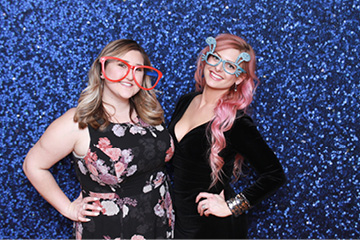In the evolving landscape of event planning, integrating innovative technologies like mirror booths has become a trend that not only enhances guest experience but also impacts the budgeting framework of events. Understanding the cost implications of integrating mirror booths is crucial for event planners across various scales, from intimate gatherings to large-scale corporate events.
Initial Investment and Setup Costs
The initial cost of acquiring a mirror booth can range from $3,000 to $9,000, depending on features and customizations. These booths come with interactive touch screens, DSLR cameras, and customizable software, which contribute to the initial investment. Renting a mirror booth for a single event can cost between $500 to $1,500, varying based on the event’s duration and location.
Operational Costs
Operational costs include staffing, transportation, and maintenance. Staffing a mirror booth requires technical knowledge for setup, operation, and troubleshooting, which can cost approximately $25 to $50 per hour. Transportation costs depend on the distance and logistics, averaging around $100 to $300 per event. Regular maintenance and software updates are also cost factors, with annual maintenance contracts ranging from $300 to $600.
Impact on Event Budgets
For small-scale events, like private parties or weddings, the integration of a mirror booth can represent a significant portion of the budget, often 10% to 15%. In contrast, for large-scale events, such as corporate gatherings or trade shows, the cost can be a smaller fraction, typically around 2% to 5% of the total budget. This disparity highlights the need for scalable solutions in event planning.
Return on Investment
The return on investment (ROI) for integrating a mirror booth comes in the form of enhanced guest engagement and potential marketing value. Capturing high-quality photos and instant social media sharing options can significantly boost the event’s visibility and attendee satisfaction, translating into tangible benefits for event organizers and sponsors.
Case Study: NE Photo Booth
NE Photo Booth provides magic mirror photo booths that can elevate the event experience. For example, at a recent mid-sized corporate event, the inclusion of a magic mirror photo booth led to increased social media engagement, with a 20% rise in online interactions post-event. This case illustrates how such an investment can pay off in terms of marketing and attendee engagement.
Long-Term Implications
The long-term cost implications of integrating mirror booths into event planning include the potential for recurring rentals or purchases, ongoing maintenance, and updates. These costs must be balanced against the expected benefits over multiple events to determine the overall financial impact.
In the realm of event planning, the integration of mirror booths has emerged as a trend that not only augments the attendee experience but also carries significant cost implications, especially when considering events of varying scales. Delving deeper into the economics, customization options, and long-term benefits of mirror booths can provide a clearer understanding of their impact on event budgets and planning strategies.
Customization and Enhanced Features
Customization is a key factor that affects the cost of integrating mirror booths into events. Advanced features like animated GIFs, augmented reality (AR) filters, and interactive games can elevate the user experience but also increase rental or purchase costs. Custom branding on photos and the booth itself turns these installations into powerful marketing tools, further justifying their expense. The cost for these added features and customizations can range from $200 to $1,000, depending on the complexity and branding requirements.
Scalability and Flexibility
The scalability of mirror booths is a critical consideration for event planners. For large-scale events, multiple booths may be required to accommodate high guest volumes, leading to bulk rental discounts or package deals. Conversely, for smaller, more intimate gatherings, a single booth with basic features may suffice, reducing the overall cost. This scalability ensures that mirror booths can be adapted to fit the budget and size of any event, making them a versatile choice for event planners.
Technological Advancements and Trends
The evolution of technology has a direct impact on the cost and appeal of mirror booths. With advancements in photo quality, social media integration, and user interaction, these booths have become more sophisticated and desirable. However, staying abreast of these trends and incorporating the latest technologies can increase costs due to the need for regular upgrades and maintenance to ensure the booth’s appeal remains high.
Long-Term Benefits and Strategic Value
Beyond the immediate financial outlay, the strategic value of mirror booths in event planning cannot be overlooked. They not only provide a source of entertainment but also serve as a tool for data collection and analytics, offering insights into guest behavior and preferences. This data can be invaluable for future event planning and marketing strategies, potentially offering a return on investment that extends well beyond the initial cost.
Integration with Event Themes and Branding
Mirror booths can be seamlessly integrated into event themes and branding, enhancing the overall cohesion and aesthetic of an event. This integration can range from simple thematic props and backdrops to fully customized software interfaces that reflect the event’s or sponsor’s branding, adding to the immersive experience for guests.
FAQs
- How much does it cost to rent a mirror booth for an event?
- Renting a mirror booth typically costs between $500 to $1,500 per event, depending on factors like duration and location.
- Can mirror booths be customized for specific events?
- Yes, mirror booths can be customized with different backdrops, props, and software interfaces to match the theme and style of the event.
- What are the main benefits of including a mirror booth in an event?
- The main benefits include enhanced guest interaction, memorable takeaways in the form of photos, and increased social media engagement related to the event.
- Are there any ongoing costs associated with owning a mirror booth?
- Yes, ongoing costs can include maintenance, software updates, and staffing for operation and troubleshooting.
- How can integrating a mirror booth into an event planning strategy improve ROI?
- Integrating a mirror booth can improve ROI by enhancing guest experience, increasing brand visibility, and providing marketing material through shared photos and social media engagement.
- How does the integration of mirror booths enhance the social media presence of an event?
- Mirror booths often feature instant social media sharing capabilities, allowing guests to post their photos directly to social media platforms, which enhances the event’s visibility and engagement online.
- What are the insurance and liability considerations when renting a mirror booth?
- Event planners should consider insurance and liability coverage for mirror booth rentals to protect against potential damages or accidents, with costs varying based on the event’s size and duration.
- Can mirror booths be used for outdoor events?
- Yes, mirror booths can be used for outdoor events, though they may require additional considerations like weather protection, power supply, and secure installation.
- How do mirror booths cater to different audience demographics?
- Mirror booths offer customizable experiences with a range of interactive features and props, appealing to various age groups and preferences, making them suitable for a wide array of events.
- How does the integration of mirror booths enhance the social media presence of an event?
- Mirror booths often feature instant social media sharing capabilities, allowing guests to post their photos directly to social media platforms, which enhances the event’s visibility and engagement online.
- What are the insurance and liability considerations when renting a mirror booth?
- Event planners should consider insurance and liability coverage for mirror booth rentals to protect against potential damages or accidents, with costs varying based on the event’s size and duration.
- Can mirror booths be used for outdoor events?
- Yes, mirror booths can be used for outdoor events, though they may require additional considerations like weather protection, power supply, and secure installation.
- How do mirror booths cater to different audience demographics?
- Mirror booths offer customizable experiences with a range of interactive features and props, appealing to various age groups and preferences, making them suitable for a wide array of events.
Conclusion
Integrating mirror booths into event planning offers a dynamic way to engage attendees and create memorable experiences. While the initial and operational costs can be substantial, particularly for smaller events, the potential for enhanced guest satisfaction and marketing reach can justify the investment. Event planners must carefully assess these cost implications in relation to the scale and objectives of their events. NE Photo Booth, with its magic mirror photo booths, exemplifies how such technology can be seamlessly integrated into events of any scale, offering customizable solutions that cater to varying needs. As the event industry continues to evolve, the integration of innovative technologies like mirror booths will likely become a standard expectation. Thus, the question arises: How can event planners leverage these technologies to not only enhance the event experience but also achieve a sustainable financial model?
Also know Enhancing Sports Events With Open-Air Photo Booths



